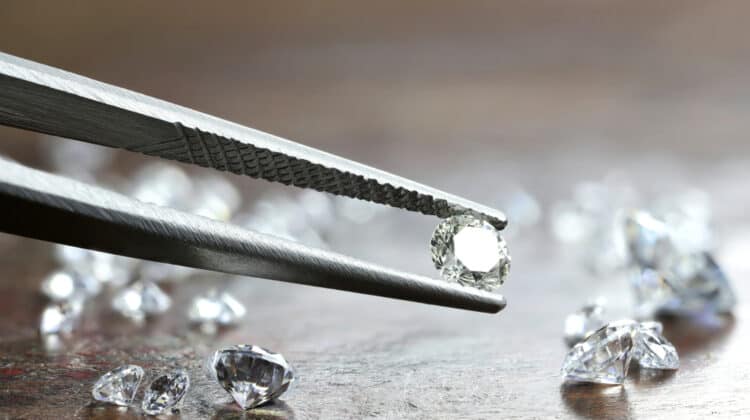
When shopping around for art, you’ll find that it usually carries a high price.
Even up-and-coming artists tend to sell their art pieces at high prices.
With some pieces selling for hundreds of dollars and others selling for millions, you may wonder what influences the price of paintings.
Here are 10 reasons paintings are so expensive.
Why Are Paintings So Expensive? (Top 10 Reasons)
1. Original Artwork

One of the reasons paintings are so expensive is that they’re original.
Artists have a unique ability to take what they see in their imagination and transform it into a physical piece that other people can see.
Besides incredible amounts of creativity, it also requires a lot of technical skills.
The reason that paintings are so expensive is that each art piece is wholly original and unique.
There can be no other exact copy.
Even the painter would be unable to make it again.
The paint may not mix exactly, the sunlight might affect the paint in some way, even the drying process can change how the paint looks.
That’s not even worrying about reproducing the same brushstrokes.
Prints don’t capture the vibrancy of the original work, either.
They’re only copies and not actual art pieces.
Because of that, there is only ever one piece that exists.
That also means that only one person can own the original work.
If an artist or a specific art piece is popular, then there’s a lot of demand for it.
However, there’s an extremely limited supply.
There’s only one.
Since a lot of people want a single piece of artwork, they have to bid for it.
The price increases from there.
It’s why some paintings from Da Vinci and Van Gogh and other classical painters go for millions.
There’s only one original version of that painting.
2. Deceased Painters

Another factor that increases the price of a painting is whether the artist is dead or not.
Death increases the value of art pieces.
That’s because the painter is unable to produce any more artwork.
There’s only a set number of paintings that they created.
Since there’s a limited supply but high demand, the prices of their paintings soar.
If the artist is still alive, then their paintings may not sell for as high of a price.
That’s because art collectors and art lovers know that they have more pieces coming out.
There’s still a supply to meet some of the demand.
Being dead also adds value to the paintings because it adds the painter’s history and personality to it.
Da Vinci is a famous painter, but he was also a master inventor.
While he already had a lot of prestige in his own time, it has since grown after his death.
The personality that was Leonardo Da Vinci transcends into his paintings.
It makes them more valuable than if he were still alive and his life yet unfinished.
You’ll find that some paintings will increase in price after the artist who created them dies.
3. Long Process

The painting process takes a long time.
Finding inspiration is sometimes the biggest struggle.
It can take a painter as little as a few seconds to a few months to many years to find inspiration for their next painting.
Some become struck by inspiration while others have to seek it.
Once they have an idea for their painting, they then need to prepare everything.
The canvas, the paints, and even some brushes need to be prepared before the painter can even begin.
While painting, the artist might hit creative roadblocks.
Their inspiration may fail them, or something may not work out how they want it to.
The paints might fail them.
They may be too dry or not mixing into the right shade of color that they need.
It’s also easy for painters to burn out if they work too hard on a single piece.
A painting can take anywhere from a day to several months to complete.
It depends on the complexity, the size, and the creative process of the artist.
Since the process as a whole can take a long time, it increases the price of the painting.
That’s because the painter has to cover those periods in which they did nothing but paint.
As one would pay a carpenter over the number of days it takes them to build a home, one also has to consider paying an artist for the number of days they labored over the painting.
You’re not only paying for the finished product but also for the length of time it took to paint it.
You can expect any painting that took a long time to make to be expensive.
4. Art Representatives

The painter isn’t the only one who sets the price on the piece.
If they have an art representative or dealer who works with them, then they’ll do a lot of negotiating on the price.
An art dealer, for example, has to hype up the artist’s works.
Doing so brings a lot of attention and interest to their pieces.
The more interest that a dealer can gather, the more the demand for the works increases.
As a result, the price increases.
This works hand-in-hand with gallery showings.
Artists usually have to pay a certain price to be featured in a gallery if they’re not invited.
A gallery wants to bring in as many people to make some money.
They’ll look for artists who have something new to say or who can set the latest art trend.
By working with the dealer and the artist, the gallery might even auction off some of their works.
With all of those people involved, everyone gets a slice of the final price.
Naturally, they want it to be as high as possible since that means they’ll come away with more money.
The more hype that an artist generates thanks to the work of art representatives, the more demand there is for their art.
With limited supply, the price for the art increases.
5. Size

The size of the painting greatly influences its price.
Small paintings may be complex, but they don’t take as much paint or time to make.
The artist needs fewer materials and can usually finish the piece in a few days or weeks.
Because of that, it fetches a cheaper price.
Large paintings, on the other hand, can be extremely expensive.
That’s because the size is really limitless.
Some artists will paint mural-sized paintings that can easily cost thousands of dollars.
Others have large canvases made specifically for them.
The larger a painting is, the more materials the artist needs to do the painting.
If they’re using a pricey set of paints, then it can increase the price from those alone.
Time is another factor.
It takes a long time to finish a large painting.
From applying several coats of paint to even finishing the outline, it can take months to finish a large painting.
The artist needs compensation for that lost time.
Larger paintings make art more expensive.
6. Unconventional Artwork

When some people think about art, they think about still lifes and Mona Lisas.
They think about Impressionism and Cubism.
They may not realize that those art styles were unconventional during the time of their origin.
Van Gogh, most famously, died poor because no one wanted his paintings.
They found the Impressionist style unconventional.
Now, his pieces sell for thousands if not millions of dollars.
Unconventional art is expensive because it introduces something new to the art world.
It gives art lovers a new way to see the world or something new to think about when looking at the piece.
Not all unconventional art will be a big hit.
Those that do, however, tend to carry a high price.
Anyone can copy a style or make a similar still life or setting.
Not everyone can introduce a brand new medium or style of painting.
Those who do tend to bring in a lot of money from their paintings because they sell for high prices.
7. Medium

In the world of painting, a medium is the type of material that the painter paints on.
There are three major mediums, but some unconventional artists will use other mediums, too.
The most expensive type of medium is a canvas.
This is a traditional medium that painters use.
Canvas works well because it gives the artist a lot of control over their brush strokes.
It also helps them apply paint instead of absorbing it.
The second most expensive medium is paper.
Paper is cheaper than canvas because it’s thinner and uses fewer materials in its production.
It’s a bit more difficult to paint on paper since it tends to absorb some of the paint.
That can make drips and smearing occur more often.
The least expensive type of medium is print.
There isn’t a lot of love for printed art.
If you see a painting at an expensive price, then it’s likely because its medium is a canvas.
The same painting on paper or print would be cheaper.
8. Association With A Famous Gallery

After an artist has worked their way up from small galleries, they may gain the attention of a large and famous gallery.
David Zwirner or Hauser & Wirth are some of the best-known galleries, for example.
Being invited to showcase at such a gallery automatically bumps up the price of the art.
It shows the rest of the art world that the artist has reached the upper echelon of mastery.
Their art is worth a significant amount.
Getting into famous galleries isn’t easy.
Some artists will spend their entire lives trying to get in one.
The galleries will go through painting after painting until they find one that appeals to them.
Since galleries tend to split the sale of the artwork with the artist 50/50, both parties strive to sell the art for as high a price as they can get.
The fact that they’re showcasing at a premium art gallery where a lot of art lovers with deep pockets look for art helps them snag high prices.
Being associated with a famous gallery can increase the price of the art through reputation alone.
9. Art Collectors

You may think that a piece of art looks dumb or not particularly skilled.
It may surprise you to think that people are buying it for thousands of dollars.
One of the reasons that people will buy art even if it doesn’t seem all that good is that art collectors are raving about it.
In the world of art, the market tends to work on a consensus model.
Art lovers look to art collectors to tell them which art pieces are significant and worth buying.
They then discuss with their fellow art lovers and if there is a consensus, then the demand for the art piece increases.
As the demand increases, so does its price.
Everyone looks to big-time art collectors with deep pockets to make the initial decision.
Sometimes art critics will also set the consensus.
If they start vying over who gets to buy it, then the rest of the art crowd realizes that something is truly special about the painting.
They want it, too, if it’s generating so much discussion and attention.
If an art collector speaks highly about a piece or attempts to outbid another collector for it, then you’ll find that the art piece quickly increases in price.
That’s even if the art doesn’t appeal to everyone.
10. Status Symbol

Art is more than a decoration for your home.
It’s supposed to be a conversation starter.
It’s supposed to make you ask questions and try to answer them.
Many simply consider art as a status symbol, though.
Because it’s expensive, and they were able to buy it, it’s a way to say to others that they’re wealthy without actually showing them their bank statements.
Art collectors and lovers tend to be rich.
They have thousands and millions of dollars lying around that allow them to make these purchases without a second thought.
They may enjoy the piece, but many buy art pieces because they want to hang it on their walls to show off their status and wealth.
Someone who owns a Van Gogh, for example, likely paid a significant amount of money for it.
When they invite guests into their homes, they can show it off.
They can have a conversation about it and casually boast how much it set them back.
Since it’s a status symbol, the market expects art to be expensive.
No one needs art to survive.
It’s a luxury instead.
Thus, paintings carry the luxury price tag.
How To Save Money On Paintings

If you want to own a few authentic and original works of art, then you may be wary of spending several thousands of dollars to do so.
Here are a few ways you can enjoy some incredible works of art in your home without going bankrupt in the process.
1. Look For Emerging Artists
Established artists are going to be far more expensive than emerging ones.
Emerging artists are still looking for a gallery to showcase their work.
They may be part of a small gallery already, but
they haven’t made it big in the art world yet.
Because of that, they can’t price their art pieces too high at the moment.
You can find incredible artists at small galleries around you.
You can also find them at art fairs and even on online marketplaces.
Not only does supporting emerging artists give you the chance to collect their earlier works, which could become valuable later on, but it also allows you to buy their earlier pieces at a cheap price.
2. Buy Small
To save money, you’ll want to look for smaller paintings.
You can fill a wall with smaller paintings and still likely find yourself saving more money than if you had bought a single large painting.
Since smaller paintings take less time and materials to make, artists sell them at a cheaper price.
Smaller paintings decorate a room just as well as a large painting.
You don’t have to empty your wallet with a smaller painting as you would with a larger painting.
3. Buy More Than One
Depending on the artist, some happily bundle their art together.
If you buy two or three instead of only one, then they might be more willing to discount one of them.
Some might even throw a small painting in for free.
Buying more than one benefits them in several ways.
It frees up inventory space, so they can paint new pieces.
It also means a lot of the time they spent making the pieces is now paid for all at once.
They also don’t have to worry about hunting down other interested parties or hawking their wares.
Buying a few extra paintings from the same artist can often land you a great deal.
4. Consider Prints Or Digital
If you want cheap paintings, then you’ll want to consider purchasing either printed paintings or digital paintings.
These are from artists who use software to make their artwork instead of traditional paint.
Photoshop and a few other painting software sites are popular.
You can receive some incredible artworks that are in print or that are digital.
You can also hang these paintings the same as if they used real paint.
Since these are the cheaper mediums, you can expect the overall price of the painting to be cheaper, too.
Conclusion
Paintings are expensive because they’re original and unique.
You can only ever buy one exactly like that one from an artist.
Copies may exist, but they’re not the same.
Art galleries and professionals can also influence the price of artwork by hyping it up.
Luckily, there are a few ways you can still buy paintings for a cheaper price.
Follow the tips above to purchase affordable paintings that look incredible.
NEXT: Why Is Creed Cologne So Expensive? (Top 10 Reasons)
























1.After going through all the content,I came on conclusion that define the value of paintings is very difficult unless one can understand the whole process of making it from its beginning to the end.It’s essential to know about its coast of making, time spends to complete it & the energy painter uses to give it perfect shape.
2.All described points above are essential to take into consideration. One of the most important point which matters the most is the imagination power of painters they get from their heart & mind. Sometimes even they don’t get back their original ideas once they used them.
3. Paintings are the byproducts of imagination, creativity and hard work.